Visit your favourite destinations |
| A Report from birdtours.co.uk |
Argentina Nov-Dec 2001,
Fauna watched on the trip
This is the complete list of the species seen during the trip, from 19th November to 6th December of 2001.
We can separate 5 zones on the trip distributed on the next days :
- Valdés Península : 19, 20, 21 and morning of 22 November.
- Glaciars Area : 22 afternoon, 23, 24, 25 and 26 of November.
- Torres del Paine : 27, 28, 29 and morning of 30 November.
- Tierra del Fuego : 1, 2, 3 and 4 of December.
- Buenos Aires : 5 and 6 of December.
Birds
As usual, there are species placed in almost every habitat visited. In this group we can find an old friend here in Europe, the House Sparrow. Another species introduced from Europe has been the Peregrine Falcon.
On the other hand, the fauna globalization doesn't work only in one way, so we could see in Buenos Aires the well known ( Barcelona is full of them ) Austral Parakeet.
In Valdés Península the most spectacular species were the simpathetic Magellanic Penguins seen in Punta Tombo in thousands and the elusive Lesser Rhea.
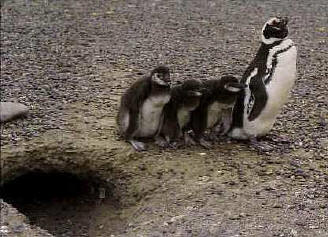
Pinguino de Magallanes ( Magellanic Penguin )
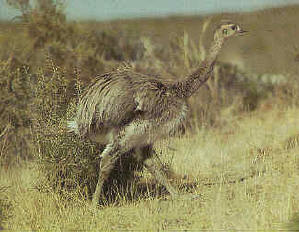
Ñandú ( Lesser Rhea )
On the other side, in the andean places it's wonderful to watch Geese distributed in their territories all over the plains..
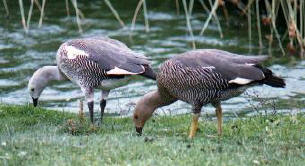
Cauquén Común ( Upland Goose )
However, the king in this place is the Andean Condor, that flies without effort across the blue and always windy Patagonia's Sky.
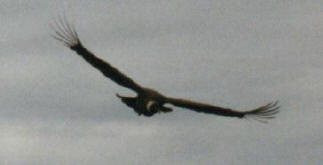
Condor de los Andes ( Andean Condor )
In Tierra del Fuego the most spectacular was a couple of Magellanic Woodpecker searching for lunch in a forest of the island. They are the greatest woodpeckers of South-America and the most curious are the female.
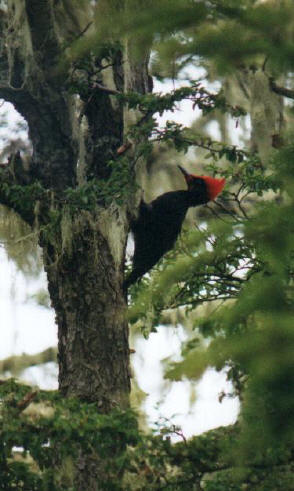
Carpintero Negro Gigante ( Magellanic Woodpecker )
Finally, in Buenos Aires we could see both kind of Cardinal that are precious, the elegant Fork-Tailed Flycatcher, the Guira Cuckoo and some water-birds.
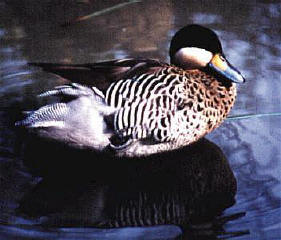
Pato Capuchino ( Silver Teal )
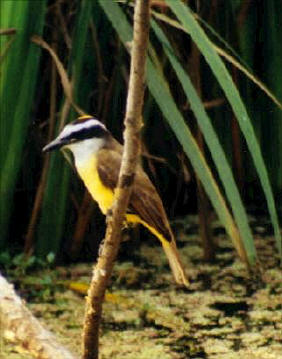
Benteveo ( Great Kiskadee )
The bird's guide used for the identification and listing has been "Birds of Southern South America and Antarctica" by Collins. In my opinion, its a very useful guide, easy to use and with good pictures.
| No. | Common Name | Scientific Name | |
|---|---|---|---|
|
1 |
Rhea | Lesser | Pterocnemia pennata |
|
2 |
Tinamou | Elegant Crested | Eudromia elegans |
|
3 |
Grebe | White-tufted | Podiceps rolland |
|
4 |
Grebe | Pied-billed | Podilymbus podiceps |
|
5 |
Grebe | Great | Podiceps major |
|
6 |
Petrel | Southern Giant | Macronectes giganteus |
|
7 |
Penguin | Magellanic | Spheniscus magellanicus |
|
8 |
Cormorant | Olivaceous | Phalacrocorax olivaceus |
|
9 |
Cormorant | Rock | Phalacrocorax magellanicus |
|
10 |
Cormorant | King | Phalacrocorax albiventer |
|
11 |
Heron | Striated | Butorides striatus |
|
12 |
Egret | Great | Egretta alba |
|
13 |
Egret | Snowy | Egretta thula |
|
14 |
Night-Heron | Black-crowned | Nycticorax nycticorax |
|
15 |
Ibis | Black-faced | Theristicus melanopis |
|
16 |
Flamingo | Chilean | Phoenicopterus chilensis |
|
17 |
Swan | Coscoroba | Coscoroba coscoroba |
|
18 |
Swan | Black-necked | Cygnus melancoryphus |
|
19 |
Goose | Kelp | Chloephaga hybrida |
|
20 |
Goose | Upland | Chloephaga picta |
|
21 |
Goose | Ashy-headed | Chloephaga poliocephala |
|
22 |
Duck | Crested | Lophonetta specularioides |
|
23 |
Duck | Spectacled | Anas specularis |
|
24 |
Wigeon | Southern | Anas sibilatrix |
|
25 |
Pintail | Brown | Anas georgica |
|
26 |
Teal | Speckled | Anas flavirostris |
|
27 |
Shoveler | Red | Anas platalea |
|
28 |
Teal | Silver | Anas versicolor |
|
29 |
Duck | Torrent | Merganetta armata |
|
30 |
Steamer-Duck | Flightless | Tachyeres pteneres |
|
31 |
Steamer-Duck | Flying | Tachyeres patachonicus |
|
32 |
Steamer-Duck | White-headed | Tachyeres leucocephalus |
|
33 |
Pochard | Rosy-billed | Netta peposaca |
|
34 |
Duck | Ruddy | Oxyura jamaicensis |
|
35 |
Duck | Lake | Oxyura vittata |
|
36 |
Condor | Andean | Vultur gryphus |
|
37 |
Vulture | Turkey | Cathartes aura |
|
38 |
Buzzard-Eagle | Black-chested | Geranoaetus melanoleucus |
|
39 |
Harrier | Cinereous | Circus cinereus |
|
40 |
Caracara | Crested | Polyborus plancus |
|
41 |
Caracara | Chimango | Milvago chimango |
|
42 |
Falcon | Peregrine | Falco peregrinus |
|
43 |
Kestrel | American | Falco sparverius |
|
44 |
Coot | Red-gartered | Fulica armillata |
|
45 |
Coot | White-winged | Fulica leucoptera |
|
46 |
Coot | Red-fronted | Fulica rufifrons |
|
47 |
Moorhen | (CommonGallinule) | Gallinula chloropus |
|
48 |
Jacana | Wattled | Jacana jacana |
|
49 |
Oystercatcher | American | Haematopus ostralegus |
|
50 |
Oystercatcher | Magellanic | Haematopus leucopodus |
|
51 |
Oystercatcher | Blackish | Haematopus ater |
|
52 |
Lapwing | Southern | Vanellus chilensis |
|
53 |
Seedsnipe | Least | Thinocorus rumicivorus |
|
54 |
Sheathbill | Snowy | Chionis alba |
|
55 |
Skua | Great | Stercorarius skua |
|
56 |
Skua | Chilean | Stercorarius chilensis |
|
57 |
Gull | Dolphin | Leucophaeus scoresbii |
|
58 |
Gull | Brown-hooded | Larus maculipennis |
|
59 |
Gull | Band-tailed | Larus belcheri |
|
60 |
Tern | South American | Sterna hirundinacea |
|
61 |
Pigeon | Picazuro | Columba picazuro |
|
62 |
Dove | Rock | Columba livia |
|
63 |
Dove | Eared | Zenaida auriculala |
|
64 |
Parrot | Burrowing | Cyanoliseus patagonus |
|
65 |
Parakeet | Austral | Enicognathus ferrugineus |
|
66 |
Parakeet | Monk | Miopsitta monacha |
|
67 |
Cuckoo | Guira | Guira guira |
|
68 |
Owl | Burrowing | Athene cunicularia |
|
69 |
Flicker | Field | Colaptes campestris |
|
70 |
Woodpecker | Green-barred | Colaptes melanochloros |
|
71 |
Woodpecker | Magellanic | Campephilus magellanicus |
|
72 |
Miner | Common | Geositta cunicularia |
|
73 |
Woodcreeper | Scimitar-billed | Drymornis bridgesii |
|
74 |
Earthcreeper | Scale-throated | Upucerthia dumetaria |
|
75 |
Earthcreeper | Straight-billed | Upucerthia ruficauda |
|
76 |
Cinclodes | Dark-bellied | Cinclodes patagonicus |
|
77 |
Cinclodes | Grey-flanked | Cinclodes oustaleti |
|
78 |
Cinclodes | Bar-winged | Cinclodes fuscus |
|
79 |
Homero | Rufous | Furnarius rufus |
|
80 |
Rayadito | Thorn-tailed | Aphrastura spinicauda |
|
81 |
Canastero | Cordilleran | Asthenes modesta |
|
82 |
Treerunner | White-throated | Pygarrhichas albogularis |
|
83 |
Elaenia | White-crested | Elaenia albiceps |
|
84 |
Diucon | Fire-eyed | Xolmis pyrope |
|
85 |
Ground-Tyrant | Ochre-naped | Muscisaxicola flavinucha |
|
86 |
Ground-Tyrant | Dark-faced | Muscisaxicola macloviana |
|
87 |
Negrito | Austral | Lessonia rufa |
|
88 |
Water-tyrant | Pied | Fluvicola pica |
|
89 |
Tyrant | Spectacled | Hymenops perspicillata |
|
90 |
Kiskadee | Great | Pitangus sulphuratus |
|
91 |
Flycatcher | Fork-tailed | Tyrannus savana |
|
92 |
Flycatcher | Swainson's | Myiarchus swainsoni |
|
93 |
Martin | Southern | Progne elegans |
|
94 |
Swallow | White-rumped | Tachycineta Ieucorrhoa |
|
95 |
Swallow | Chilean | Tachycineta leucopyga |
|
96 |
Swallow | Blue & White | Notiochelidon cyanoleuca |
|
97 |
Wren | House | Troglodytes aedon |
|
98 |
Gnatcatcher | Masked | Polioptila durmicola |
|
99 |
Mockingbird | Chalk-browed | Mimus saturninus |
|
100 |
Mockingbird | Patagonian | Mimus patagonicus |
|
101 |
Thrush | Rufous-bellied | Turdus rufiventris |
|
102 |
Thrush | Austral | Turdus falklandii |
|
103 |
Cardinal | Yellow-billed | Paroaria capitata |
|
104 |
Cardinal | Red-crested | Paroaria coronata |
|
105 |
Seedeater | Double-collared | Sporophila caerulescens |
|
106 |
Warbling-Finch | Black-and-rufous | Poospiza nigrorufa |
|
107 |
Diuca Finch | Common | Diuca diuca |
|
108 |
Sierra-Finch | Grey-hooded | Phrygilus gayi |
|
109 |
Sierra-Finch | Patagonian | Phrygilus patagonicus |
|
110 |
Sierra-Finch | Mourning | Phrygilus fruticeti |
|
111 |
Sierra-Finch | Carbonated | Phrygilus carbonarius |
|
112 |
Sparrow | Rufous-collared | Zonotrichia capensis |
|
113 |
Siskin | Hooded | Carduelis magellanica |
|
114 |
Siskin | Black-chinned | Carduelis barbata |
|
115 |
Blackbird | Unicoloured | Agelaious ruficapillus |
|
116 |
Blackbird | Austral | Cusraeus curaeus |
|
117 |
Blackbird | Yellow-winged | Agelaius thilius |
|
118 |
Cowbird | Shiny | Molothrus bonariensis |
|
119 |
Meadowlark | Long-tailed | Sturnella loyca |
|
120 |
Sparrow | House | Passer domesticus |
Making a resume of species seen each day distinguishing total number of species and new ones in a day we obtain the next graphic.
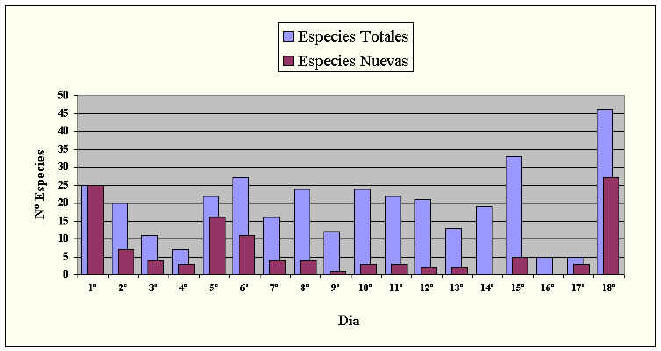
Mammals and reptiles
As usually, the mammal and reptile watching is much more difficult than bird watching.
One surprise it's the great quantity of rabbits spread Argentina. They were brought by the europeans and they are replacing dangerously some of the indigenous species of the place, as Maras that are more difficult to see.
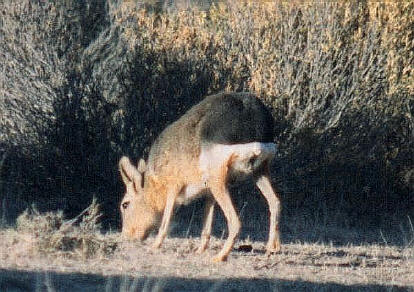
Mara
Another species introduced and well adapted in Tierra de Fuego has been the Beaver. Brought from Canada, its activities in rivers produces great changes in the environment and can be harmful. Because of its nocturnal life, we couldn't see them but we could see their haunts, places with multiple dams till 1,5 meters high and trees recently cut by their powerful jaws. Their constructions let them change their environment for their benefit.
The Guanaco is one of the species more seen thanks to the protection programs planned in the national parks. It have became a common animal and starts to be a problem for the cattle because it a competes for the same pastures as the sheep.
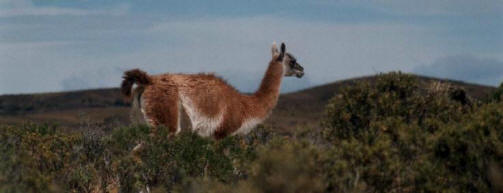
Guanaco
Another speace well adapted to the diferent climates of Patagonia because of their great versatility is the Grey Fox which we could see very near.
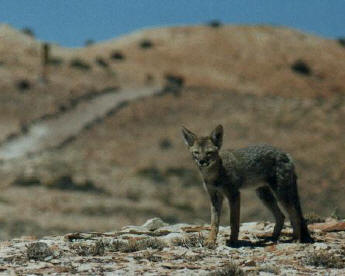
Grey Wolf
However, the stars of the trip were the Frank Whales we could see in Península Valdés. Although they weren't at the time of the most activity, there were still many females with their babys and they let us approach closely with the boat.
Also in Península Valdés it's spectacular to see the loberias and elefanterias so near and with the animals so quiet.
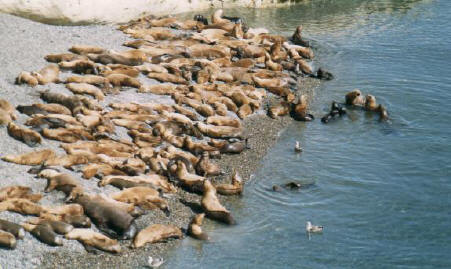
Loberia
On the other hand, it could be impossible to see some species of this region that aren't easy to see, like orcas, dolphins or puma. It will have to be in other occasion.
The list of the observed species is the following
| No. | Nombre Común |
Nombre Científico |
|---|---|---|
|
1 |
Frank Whales |
Eubalaena australis |
|
2 |
Seal | Otaria flavescens |
|
3 |
Sea Elephant | Mirounga leonina |
|
4 |
Grey Fox | Urocyon cinereoargenteus |
|
5 |
Rabbit | Oryctolagus cuniculus |
|
6 |
Mara | Dolichotis patagonum |
|
7 |
Coipú | Myocastor coypus |
|
8 |
Cui | Cavia pamparum |
|
9 |
Guanaco | Lama guanicoe |
|
10 |
Mofeta | Conepatus |
|
11 |
Overo Lizard | Tupinambis teguixin |
|
12 |
Lake's Turtle | Phrynops hilarii |
Why not send us a report, or an update to one of your current reports?